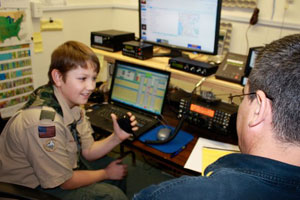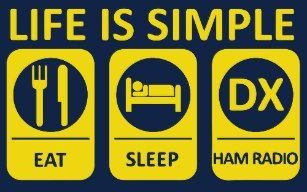Suggested Frequencies
- All frequencies are shown as megahertz.
- Primary HF recommendations are for General Class licensees. Technicians may take advantage of 10 m and VHF/UHF for voice communications.
- After contact is made on Calling Channel or frequency, move to another channel or frequency for QSO.
- Experiment with modes prior to JOTA or Radio Scouting demo. ‘Murphy’s Law’ prevails!
- Use web search tools to find lots of helpful information about any of the modes commonly used for JOTA and Radio Scouting.
- WOSM (World Organization of the Scouting Movement) calling frequencies are shown to indicate center of international activity.
HF SSB Voice
| Band | WOSM Calling Frequencies | Suggested Band Segment for US Stations | Notes |
| 80 m | 3.940 & 3.690(1) | 3.920 – 3.940 3.670 – 3.690 (1) |
(1) Extra segment |
| 40 m | 7.190 & 7.090 (2) | 7.180 – 7.200 7.270 – 7.290 |
(2) 7.090 not available in Region 2 |
| 20 m | 14.290 | 14.270 – 14.290 14.320 – 14.340 |
|
| 17 m | 18.140 | 18.140 – 18.150 | |
| 15 m | 21.360 | 21.360 – 21.400 | |
| 12 m | 24.960 | 24.960 – 24.980 | |
| 10 m | 28.390 (3) | 28.350 – 28.400 (3) | (3) Includes Novices & Techs |
| 6 m | 50.160 | 50.160 – 50.200 |
HF CW
| Band | WOSM Calling Frequencies | Suggested Band Segment for US Stations | Notes |
| 80 m | 3.570 (3) | 3.560 – 3.570 (3) | (3) Includes Novices & Techs |
| 40 m | 7.030 (3) | 7.030 – 7.040 (3) | (3) Includes Novices & Techs |
| 20 m | 14.060 | 14.050 – 14.060 | |
| 17 m | 18.080 | 18.070 – 18.080 | |
| 15 m | 21.140 (3) | 21.130 – 21.140 (3) | (3) Includes Novices & Techs |
| 12 m | 24.910 | 24.900 – 24.910 | |
| 10 m | 28.180 (3) | 28.170 – 28.180 (3) | (3) Includes Novices & Techs |
| 6 m | 50.160 | 50.150 – 50.160 |
HF PSK-31
Call CQ JOTA. The chart below shows the commonly used frequencies for PSK-31.
| Band | Frequency | Notes |
| 80 m | 3.580 | |
| 40 m | 7.080 (4) | (4) Region 2 (USA). 7.040 to 7.060 for Regions 1 & 3 |
| 30 m | 10.142 | |
| 20 m | 14.070 (5) | (5) Most activity for JOTA will be on 20 m |
| 17 m | 18.100 | |
| 15 m | 21.080 (6) | (6) Most activity can be found at 21.070 |
| 12 m | 24.920 | |
| 10 m | 28.120 |
2 Meter FM Simplex
147.450, 147.480, 147.510, 147.540* * Use 147.540 as Calling Channel. Always listen first to avoid interfering with another QSO or auxiliary or control link. Avoid 146.520, the National FM Simplex Calling Frequency, as well as 146.550, which is commonly used by mobiles and RVers.
70 CM FM Simplex
446.000*, 445.950, 446.050, 446.100, 446.150 * Use 446.000 as Calling Channel. Always listen first to avoid interfering with another QSO or auxiliary or control link.
D-STAR
REF033A has been allocated as a full-time JOTA/Radio Scouting D-STAR Reflector. After contact is established, stations should disconnect from REF033A and connect to one or other repeater or migrate to an unused Reflector.
SIMPLEX Channels: 145.670*, 145.640, 145.610, 438.010. * 145.670 and 438.010 are commonly used as the National D-STAR Simplex Channels and should be used only as Calling Channels for JOTA. Always listen first to avoid interfering with another QSO.
DMR
Use TG-907
All wide area talkgroups are permitted for use for JOTA for establishing contacts. After contact is established, stations should utilize as few resources as possible. For international, national, and regional QSO’s, stations should move their transmissions to one of the DMR-MARC UA talkgroups or to the DCI TAC-310 talkgroup.
For intrastate contacts, stations may use their area’s statewide talkgroup (if applicable). The use of your repeater’s local talkgroup (if applicable) is always permitted. A full list of repeaters and their available talkgroups can be found at http://www.dmr-marc.net/repeaters.html.
SIMPLEX Channels: 441.0000*, 446.5000, 446.0750, 433.4500, 145.7900*, 145.5100. All simplex frequencies operate on time-slot 1 and use color code 1. (*are commonly used as the National DMR Simplex Channels and should be used only as Calling Channels for JOTA. Always listen first to avoid interfering with another QSO.)
DMR-Brandmeister
Talk Groups : https://brandmeister.network/?page=talkgroups
Reflectors : http://registry.dstar.su/dmr/reflector.db
IRLP
http://www.irlptopics.net
Use Topic Channel Node 9091 as a Common Meeting Place or Calling Channel. After contact, disconnect from 9091 and one station should connect to another’s local node.
EchoLink
Software or apps available for Windows, Mac, iPhone/iPad, and Android. Dedicated Conference Node *JOTA-365* (node 480809). When contact is made on a Conference Node, it is recommended the two parties establish direct contact with each other to free up the Conference Node.
APRS
144.39
CQSRVR: CQ JOTA
CQSRVR: CQ SCOUTS (other times of the year)
Insurance
Check your insurance coverage for your equipment and, if the Scouts are visiting your ham station, your premises. This is just one more element to verify before the event to avoid any problems repairing or replacing equipment damaged during the event.
Publicity
You’re encouraged to send news releases of the event to your local newspapers and television and radio stations. You can encourage photographers to attend the event. You can also forward photos to your local news media, including weekly papers. A sample news release is included on this website.
General Guidelines
 Jamboree-on-the Air is about getting young people to talk to each other using amateur radio.
Jamboree-on-the Air is about getting young people to talk to each other using amateur radio.- Arrange for the use of a club call sign, or apply for a special-event call sign in plenty of time.
- Prepare some simple diagrams and explanations showing how radio works and how signals can be transmitted around the world as well as to the nearest repeater.
- Arrange with the Scout leaders regarding venue, QSL cards, patches, participation certificates, other activities, physical arrangements, publicity, and details required for the JOTA report form on this website.
- Notify the national JOTA organizer of your event using the details on the registration form on this site.
- Go to Scout meetings beforehand to introduce the subject.
- Organize activities such as kit building, soldering practice, SSTV, FSTV, packet radio, and weather satellite reception. The simplest of things, such as a closed-circuit RTTY station, can generate a great deal of excitement.
- Offer to train Scouts for the Radio merit badge.
- Offer a Technician license preparation course for those interested in learning and doing more with ham radio.
- Ensure that no more than three Scouts are watching one Scout on the air. Keep Scouts involved and active or they will quickly grow bored.
- Ensure that the station is safe for young visitors.
- Observe your license conditions, especially regarding third-party traffic.
- Involve the Scouts in the contact. The goal is to involve as many Scouts as possible in making a contact. It is not to maximize the number of contacts or the distance of the contacts; it’s about the experience for the Scouts.
- Try to use plain, understandable English where possible. When you do use Q-signals and other ham radio terms, take time to explain them to the Scouts.
- Don’t try to work weak stations from remote locations. Go for stronger, more local stations that unpracticed ears can hear easily and understand. Local FM repeaters can be just as exciting for Scouts.
- Don’t feel you have to keep the station on the air with no Scouts present.
Useful Internet Sites
K2BSA Amateur Radio Association
http://www.k2bsa.net
BSA JOTA Information
http://www.scouting.org/jota.aspx
World Organization of the Scout Movement JOTA Information
http://www.scout.org/jotajoti/
ARRL JOTA Information
http://www.arrl.org/jamboree-on-the-air-jota
Scout Camps on the Air
http://scota.us
Discussion Groups
Best all-around Radio Scouting discussion group
http://groups.yahoo.com/group/ScoutRadio/
Final Thoughts
It’s recommended that you also look over the “Guidelines for Scout Leaders.” It will give you an idea of the necessary preparation by your partners in the event, and perhaps you’ll see areas where you can help.
Best wishes for a great Jamboree-on-the-Air. We look forward to hearing all about it in your JOTA report.

